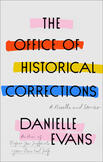Inside the catastrophe itself: Blame and shame in the short stories of Danielle Evans
In “Alcatraz,” a story from Danielle Evans’s collection The Office of Historical Corrections, the narrator gets a tattoo of William Faulkner’s famous maxim: “The past isn’t dead. It isn’t even past.” By the time we meet her, she already views this tattoo with wry dismay—it is a reminder of how thoroughly her life has been shaped by her mother’s project of restoring the reputation of a long-dead Alcatraz prisoner.
The meaning of a tattoo shifts with time as the person who gets it slowly becomes the person who has to live with it. A tattoo is itself an attempt to make something stay true. It is an attempt to stay the kind of person that you are. Therefore its meaning will always change as boast becomes confession, delight becomes discipline, hope is chastened and truth is stretched to cover our uncertainties. The Faulkner tattoo is true—but it can be true as a warning or as hope.
In some stories, Danielle Evans suggests that indefatigable commitment to historical truth may warp and damage us, but it can also cleanse some wounds.
Evans has noticed how many of our current conflicts center on how to understand, heal from, punish, honor or make amends for past actions, from “cancel culture” to the freelance demolition of Confederate memorials to the #MeToo movement. In this collection, we meet a white girl who “goes viral” after posing in a bikini with a Confederate flag pattern, an artist who may have realized that shifting cultural sands have turned him from lothario into abuser, and two Black women who take opposing approaches to the rectification of public historical falsehoods. These are stories of forged IDs and dubious death certificates, of the aggression lurking in apologies and the truth hidden in disproven accusations. If they sometimes seem a touch too blatantly ripped from the headlines, that is likely because the headlines nowadays reflect Evans’s own concerns.
Evans’s previous collection, Before You Suffocate Your Own Fool Self, published in 2010, mixed slice-of-life stories with more exaggerated tales of moral choice.Her talents seem to lie in this heightened realm. In the new collection, my own favorite is the most allegorical entry, “Why Won’t Women Just Say What They Want.” In this tale of iconic figures, like “the Former Personal Assistant” and “the On-Again Off-Again Ex of His Wayward Youth,” a man called “the artist” apologizes. He apologizes to all of the women in his life—via pop-up galleries and billboards and phone games, shameless public acts of what might be self-abasement or self-promotion. This public making of amends has unpredictable private consequences: Some women feel vindicated, others bereft. One is inspired to make her own amends to somebody else and is rebuffed, while another becomes “The Girl So Stunned by Her Apology That It Sent Her to Therapy Because She Had No Recollection of Meeting Him, Let Alone Having Sex With Him.”
Danielle Evans writes stories of the aggression lurking in apologies and the truth hidden in disproven accusations.
Evans brutally and deliciously parodies bad apologies, and she satirizes the growing apology-P.R. industry. But unlike some expressions of the contemporary backlash against apologies, this parable lacks self-righteousness. Evans knows how insufficient apologies are—and how often we long for them anyway—whether we are receiving them or making them. She writes, “Why are you like this? the Daughter wanted to ask everyone involved, but she sensed on some level that the question would be hypocritical, that she too was like something, and just didn’t know what yet.” The story’s final twist suggests that the artist himself underestimated how much his apologies might cost him.
At times Evans shows a deft comedic touch, as when she describes a woman alone with another woman’s boyfriend as “doing the dance of the seven red flags.”Her writing can also be gut-wrenching, as when she describes a Black woman forced to watch as the Black men she loves learn to hold themselves so carefully; men learn fear and women helpless sorrow, “how to watch a man worry about his body and the conditions under which someone might take his any gesture the wrong way.”
In “Boys Go to Jupiter,” the Confederate-bikini story, she emphasizes the way grief can isolate a person and make her cling to her isolation out of pride. “Claire’s anger has always been her own,” the narrator notes. Claire, the white undergraduate facing a clamoring tribunal of her peers, has not received much guidance in life and has not asked for any. She lashes out. She defends herself to the point of willingly becoming a caricature, a living falsehood (she even affects a Southern drawl). This is a kind of character familiar to fans of Young Adult media, though mostly reserved for boys: Think Severus Snape or Logan Echolls. Evans lets the story play out until you are miserably certain there is no way back for Claire, neither forgiveness nor repentance—and then stops the story with an abruptness that might have appeared cheap in less-skilled hands, but here seems like the only way of preserving any possibility of a different outcome.
The final story is even less confident in the possibilities of reconstruction. Cassie, a Black woman who nowadays might get called an “institutionalist” (she loves Brutalism!) or a “normie,” works for the Institute for Public History, a government office dedicated to correcting historical misinformation. She is sent to rural Wisconsin to investigate an old but still remembered atrocity. In 1937, the white citizens of Cherry Mill burned down a Black newcomer’s home and business. They also assumed they had killed him. The first records of this violence were searing, moral and totally opposed: reports in Black newspapers versus a commemorative lynching photo for the perpetrators’ family albums. But times changed, and the town put up a plaque acknowledging its racist history.
Cassie’s professional rival, a driven radical named Genevieve, wants to modify the plaque to list the names of the killers, many of whom have descendants still living in the town. As controversy over Genevieve’s plan rises, new evidence suggests that the town’s Black victim may have escaped the mob. But the reasons behind his sojourn in this American Sodom—a burning city of the plain, defined for posterity by its merciless violence toward outsiders—threaten to expose more secrets, stranger and wider-reaching shames. Both white and Black townspeople have hidden their true histories. They had different reasons for their betrayals. Does that change their guilt?
In some stories, like the posthumous-pardon drama “Alcatraz,” Evans suggests that indefatigable commitment to historical truth may warp and damage us, but it can also cleanse some wounds. Maybe, for some people, hope is not lost; it has just been deliberately misfiled. But in this final story Evans gives no solace. (The names here are important: Cassandra, our narrator; Minerva, the victim’s sister, the goddess of wisdom whom we always meet too late.) Evans does not stop the narrative before the full catastrophe. She stops where we are now: inside the catastrophe itself.











